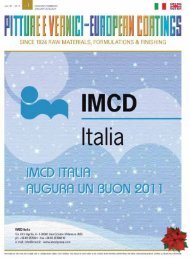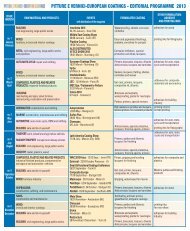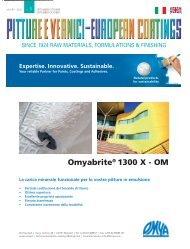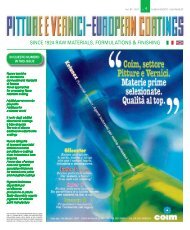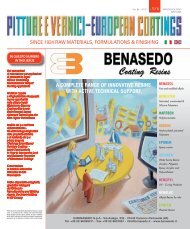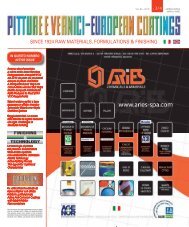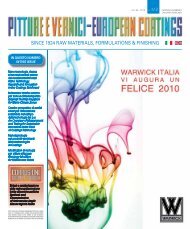since 1924 raw materials, formulations & finishing - PITTURE E ...
since 1924 raw materials, formulations & finishing - PITTURE E ...
since 1924 raw materials, formulations & finishing - PITTURE E ...
You also want an ePaper? Increase the reach of your titles
YUMPU automatically turns print PDFs into web optimized ePapers that Google loves.
L’associazione per i progetti Migresives<br />
ha presentato e discusso i risultati dei<br />
lavori di ricerca compiuti in più di 3 anni<br />
in chiusura della conferenza il 27 e il 28<br />
aprile a Ljubljana.<br />
I 150 partecipanti provenienti da tutti gli<br />
stati europei, dagli USA, dal Giappone<br />
e dall’Arabia Saudita hanno preso parte<br />
alla conferenza.<br />
Migresives è un progetto di ricerca<br />
Europeo (COLL-CT-2006-030309) nell’ambito<br />
del sesto Programma di Ricerca<br />
della Piattaforma UE a supporto delle<br />
piccole e medie imprese.<br />
Le finalità perseguite dal progetto Migresives<br />
sono lo sviluppo di un una metodologia<br />
d’analisi con base scientifica<br />
e pragmatica per garantire l’utilizzo<br />
sicuro degli adesivi impiegati nei<br />
materiali a contatto con i prodotti alimentari.<br />
Le formulazioni degli adesivi sono spesso<br />
molto complesse e contengono numerosi<br />
componenti individuali.<br />
La presentazione del lavoro e dei risultati<br />
del progetto sono stati fissati nel<br />
quadro delle aspettative e delle implicazioni<br />
per i legislatori, piccole e medie<br />
imprese e associazioni, ma anche per altre<br />
parti in causa, in particolare chi si occupa<br />
di imballaggi, per l’industria alimentare,<br />
i laboratori d’analisi e ispezione<br />
e gli organismi preposti alla sicurezza<br />
dei prodotti alimentari.<br />
Nella sessione preliminare la Dottoressa<br />
Annette Schafer della Commissione<br />
europea, DG Sanco, ha fatto il punto sulla<br />
situazione legislativa degli adesivi nei<br />
materiali a contatto con i prodotti alimentari<br />
e le sue aspettative da questo<br />
progetto.<br />
La sessione principale della prima giornata<br />
si è incentrata sulla presentazione<br />
scientifica dei risultati del progetto<br />
realizzato dai partners R&D Fraunhofer<br />
IVV, FABES, INRA, Università di Saragoza<br />
e CTCPA: metodi analitici per selezionare<br />
e determinare le sostanze adesive<br />
nei materiali e la migrazione, migrazione<br />
sistematica e studi selettivi per<br />
ricavare i parametri utili a prevedere la<br />
migrazione, la valutazione dei dati e la<br />
caratterizzazione matematica.<br />
Dagli esperimenti sono stati ricavati più<br />
di 1200 casi di migrazione e di coefficienti<br />
di diffusione e di distribuzione, a<br />
differenti temperature e in vari materiali.<br />
Questi sono i principali parametri per<br />
prevedere la migrazione mediante caratterizzazione<br />
matematica.<br />
Da questi dati è possibile ottenere una<br />
valutazione generale dei coefficienti di<br />
diffusione negli adesivi acrilici, vinilici<br />
e a base di gomma oltre alla plastica,<br />
alla carta e al cartone.<br />
Coefficienti di ripartizione sono stati ricavati<br />
da 39 sostanze in 224 condizioni,<br />
che possono essere utilizzate direttamente<br />
per prevedere la migrazione.<br />
Per ulteriori sostanze, sono stati proposti<br />
i coefficienti di ripartizione campione,<br />
per i gruppi di sostanze polari, a polarità<br />
media e non polari.<br />
Questi strumenti sono incorporati in una<br />
metodologia di test e in un diagramma<br />
operativo che verrà pubblicato come raccolta<br />
di linee guida.<br />
L’utilizzo degli strumenti e l’applicazione<br />
del diagramma operativo sono stati<br />
presentati il secondo giorno insieme<br />
al software di modellizzazione pluristratificata,<br />
sviluppato da INRA e disponibile<br />
a breve sul sito Migresives<br />
POST EVENTI<br />
MIGRESIVES: LA MIGRAZIONE DEGLI ADESIVI NEI MATERIALI PER IMBALLAGGI<br />
ALIMENTARI – IL BUON ESITO DELLA CONFERENZA DI LJUBLJANA<br />
The Migresives project consortium had<br />
presented and discussed the results of more<br />
than 3 years of research work at the closing<br />
conference on 27 and 28 April in Ljubljana.<br />
150 participants from all over Europe,<br />
USA, Japan and Saudi Arabia joint the conference.<br />
Migresives is a European research<br />
project (COLL-CT-2006-030309) within the<br />
6 th EU Framework Collective Research Programme<br />
in support of small and medium size<br />
enterprises. It was the intention of the Migresivesproject<br />
to develop a pragmatic,<br />
science based test concept to ensure the<br />
safety-in-use of adhesives used in food contact<br />
<strong>materials</strong>. Adhesives <strong>formulations</strong> are<br />
often very complex and contain numerous<br />
single components. The presentation of<br />
the project work and results was set into the<br />
frame of the expectations towards the project<br />
and implications of the outcome to the<br />
legislator, the adhesive SMEs and associations<br />
as well as all other stakeholders especially<br />
the packaging converters, food industry,<br />
surveillance laboratories and the food<br />
safety authorities. In the introductory session<br />
Dr. Annette Schäfer from the European<br />
Commission, DG Sanco pointed out the food<br />
(www.migresives.eu).<br />
Sono state inoltre realizzate<br />
altre unità didattiche<br />
da ITECH, per insegnare<br />
e capire i requisiti<br />
legislativi relativi<br />
ai prodotti alimentari,<br />
ai processi di diffusione<br />
e di migrazione, all’utilizzo<br />
degli strumenti e<br />
del software Migresives.<br />
Uno studio della fattibilità<br />
per un approccio<br />
complementare è stato<br />
presentato dall’Università<br />
del Burgundi con l’utilizzo di prove<br />
biologiche.<br />
L’applicabilità della modellizzazione<br />
matematica agli strati adesivi, alla carta<br />
e al cartone per prevedere la migrazione<br />
nei prodotti alimentari e simili è<br />
stata uno dei temi chiave della conferenza<br />
e si prevedono ulteriori applicazioni,<br />
ad esempio nei rivestimenti nel<br />
campo della stampa.<br />
POST EVENTS<br />
Migresives: Migration from adhesives<br />
into food packaging <strong>materials</strong><br />
Successful Closing Conference in Ljubljana<br />
regulatory situation of adhesives in food contact<br />
<strong>materials</strong> and her expectations towards<br />
the project. The main part of the first<br />
day was the scientific presentation of the<br />
project outcome performed by the R&D partners<br />
Fraunhofer IVV, FABES, INRA, University<br />
of Zaragoza and CTCPA: analytical<br />
methods for screening and determination of<br />
adhesive substances in the <strong>materials</strong> and the<br />
migration, systematic migration and partitioning<br />
studies in order to derive parameters<br />
for the prediction of migration, the evaluation<br />
of the data and the mathematical<br />
modelling. From the experiments more than<br />
1200 migration and diffusion and partition<br />
coefficients have been derived at different<br />
temperatures and in different <strong>materials</strong>.<br />
These are the main parameters for the prediction<br />
of migration via mathematical modelling.<br />
From these data a general estimation<br />
of the diffusion coefficients in acrylic, vinylic<br />
and rubber adhesives as well as in plastics,<br />
paper and board could be derived. Partition<br />
coefficients were obtained for 39 substances<br />
in 224 conditions.<br />
These can be directly used for the migration<br />
prediction. For additional substances, ref-<br />
Infine, il progetto Migresives ha fornito<br />
opportunità per ridurre i costi del produttore<br />
di adesivi e per esplorare la conformità<br />
relativa alle diverse applicazioni,<br />
ad esempio nel corso dello sviluppo del<br />
prodotto, la conformità della valutazione<br />
dei prodotti esistenti (documentata),<br />
consentendo al produttore/trasformatore<br />
di imballaggi e all’industria di calcolare<br />
la migrazione e di valutare la conformità<br />
ad un’applicazione data.<br />
erence partition coefficients were proposed<br />
for the groups of polar, medium polar<br />
and non-polar substances. These tools<br />
are embedded into a testing concept and a<br />
decision tree which will be published as<br />
guidelines. The use of the tools and the application<br />
of the decision tree were presented<br />
on the second day, as well as the multilayer<br />
modelling software developed by INRA<br />
which will be shortly available from the Migresives<br />
website (www.migresives.eu).<br />
Furthermore training lessons have been<br />
worked out by ITECH to teach and understand<br />
the food regulatory requirements, diffusion<br />
and migration processes, use of the<br />
Migresives tools and the software. A feasibility<br />
study for a complementary approach<br />
was presented by the University of<br />
Burgundy using bioassays.<br />
The applicability of mathematical modelling<br />
to adhesive layers, to paper and board for<br />
prediction of migration into food and simulants<br />
met high interest in the conference and<br />
further applications e.g. in printing layers are<br />
envisaged. Thus the Migresives project<br />
provided cost saving tools for the adhesive<br />
producer, to explore conformity related to various<br />
applications e.g. during product development,<br />
conformity evaluation of existing<br />
products (supporting documents), for the<br />
packaging producer/converter and food industry<br />
to calculate migration and evaluate<br />
conformity for the given application.<br />
Pitture e Vernici - European Coatings • 7-8 /2010 35




